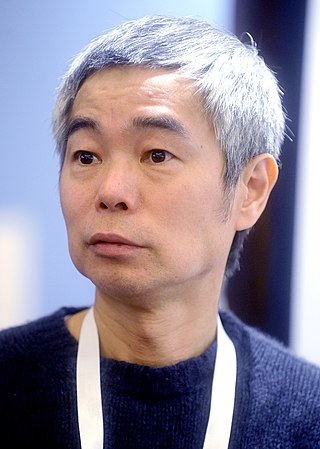Top Qs
Timeline
Chat
Perspective
Taiyō Matsumoto
Japanese manga artist From Wikipedia, the free encyclopedia
Remove ads
Taiyō Matsumoto (Japanese: 松本 大洋, Hepburn: Matsumoto Taiyō; born October 25, 1967) is a Japanese manga artist. Active as a professional manga artist since the 1980s, he is known for his experimental style and genre-blending works such as Tekkonkinkreet, Ping Pong, and No. 5. Influenced by Katsuhiro Otomo and French bande dessinée, his art combines psychological depth with rough, expressive lines. Matsumoto has won multiple awards, including the Eisner Award and Tezuka Osamu Cultural Prize.
Remove ads
Career
Summarize
Perspective
Matsumoto was born in Tokyo. Originally, he wanted to become a soccer player. but changed to artist as an occupation instead after reading Katsuhiro Otomo's Domu: A Child's Dream. While studying literature at Wako University, he started drawing manga. He was an admirer of the manga artist Seiki Tsuchida and sent his work to the newcomer contest Comic Open of Kodansha's magazine Morning that Tsuchida was working for. After his initial success in the Comic Open contest, he did a self-financed tour of France in 1986, visiting the Paris-Dakar Rally, an event that became a significant point in his career.[9][10][11]
Matsumoto published his first manga in 1987 at the age of 20 in Morning with Straight. While he published a few works there, he didn't gain enough popularity and was eventually not able to publish anymore in big magazines like Morning. Instead, he came in contact with Yasuki Hori, editor at Shogakukan, who pushed him to draw a manga about boxing, which became Zero and was published in the magazine Big Comic Spirits between 1990 and 1991.[12]
In 1993, he began work on the Tekkonkinkreet manga, which became a success in the Big Spirits magazine, and published a series of short stories in a collection called Nihon no Kyodai that was publicized at the time by Comic Aré magazine. Ping Pong appeared in Big Spirits in 1996, soon followed by the series No. 5 in Shogakukan's Monthly Ikki magazine in 2000.[9][13]
The Tekkonkinkreet anime was released in Japan in late 2006, and both the anime and manga have been published in English.[11]
Remove ads
Style
Summarize
Perspective
Themes
The manga he produced covers a variety of topics, from sports manga to family comedies to science fiction epics. Manga critic Natsume Fusanosuke divided his manga series in 2021 into different distinct categories: Manga like Zero, Hanaotoko and Ping Pong that work within the artistic framework of shōnen manga and seinen manga and that were developed with the pressure of editors in mind that wanted him to fit into the industry's standards. However, dystopian science-fiction manga like Tekkonkinkreet and No. 5 as well as the autobiographical orphanage story Sunny in a lot of ways break with many conventions of the manga industry's norms. Fusanosuke analyzes that these manga follow a path that has been developed after the success of Katsuhiro Otomo and are influenced by French bande dessinée.[12]
His worldbuilding often, for example in No 5 and Takemitsuzamurai, includes with emotionally expressive animals— who observe the action with equal narrative weight as the human characters. This constant decentering, according to Sean McTiernan, introduces a kind of “planet-building,” shifting focus from protagonist drama to ambient life, undermining the usual ego-centric logic of genre fiction.[10]
His work is seen as "meta manga", often criticizing the genres within which they operate.[12] The manga Takemitsuzamurai breaks with traditions of historical samurai stories by highlighting inner psychology of characters and avoiding normalized depictions of violence.[14]
Visual style
Matsumoto draws free-hand, with sketchy wavering lines. His lines are, according to Natsume Fusanosuke, often messy, aggressive, and “ugly”, conveying not beauty but psychological friction and intensity. This aligns with what Fusanosuke terms arasa (荒さ, roughness) and bōryokusei (暴力性, violence), key terms in Japanese art criticism that point to Matsumoto’s deliberate embrace of disorder and raw emotion.[12]
Matsumoto uses skewed angles, contorted facial expressions, and cramped compositions to evoke sensations that go beyond narrative clarity. As Fusanosuke writes, “his drawings may be hard to read, but they leave an impact.” Panels often appear unfinished or asymmetrical, with frequent use of extreme close-ups and fisheye perspectives, heightening the reader’s sense of disorientation or immersion. Especially in works like Ping Pong, these techniques reflect the inner states of characters more than external realism, what Natsume calls a “psychological realism” through form. The panel composition in Ping Pong is used to evoke the feeling of speed.[15][12]
Influences

Matsumoto has cited Moebius, Enki Bilal, Katsuhiro Otomo, Shotaro Ishinomori and Tsuchida Seiki as influences on his work.[16] He has been influenced by the New Wave movement in manga.[17]
Remove ads
Reception
Summarize
Perspective
His work has been translated in English as early as 1997, which makes him one of the earlier manga artists whose work was translated. The early English-language translations of his work were commercially not successful, but were later seen as important on shaping appreciation for alternative manga. Later re-releases were positively received.[10]
Ping Pong and Blue Spring have been adapted into live-action feature films. Animation studio Studio 4°C adapted Tekkonkinkreet into an animated feature film, it was released in Japan in late 2006, and both the anime and manga have been published in English.
Matsumoto influenced younger manga artists like Eiichiro Oda,[18] Masashi Kishimoto,[19] and Daisuke Igarashi.[20]
He has won several awards, including the Shogakukan Manga Award, the Tezuka Osamu Cultural Prize and Eisner Award:
Personal life
Matsumoto's wife is manga artist Saho Tono, who collaborated with him on Takemitsuzamurai and Sunny.[30][31] He is the cousin of Santa Inoue, another manga artist.[11]
Works
Remove ads
References
External links
Wikiwand - on
Seamless Wikipedia browsing. On steroids.
Remove ads

